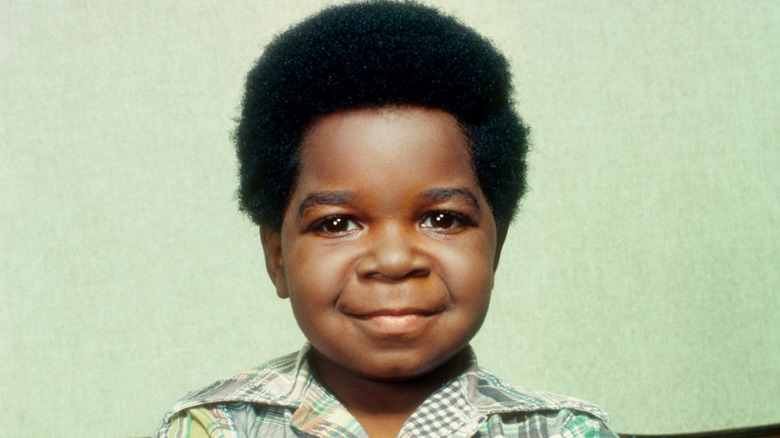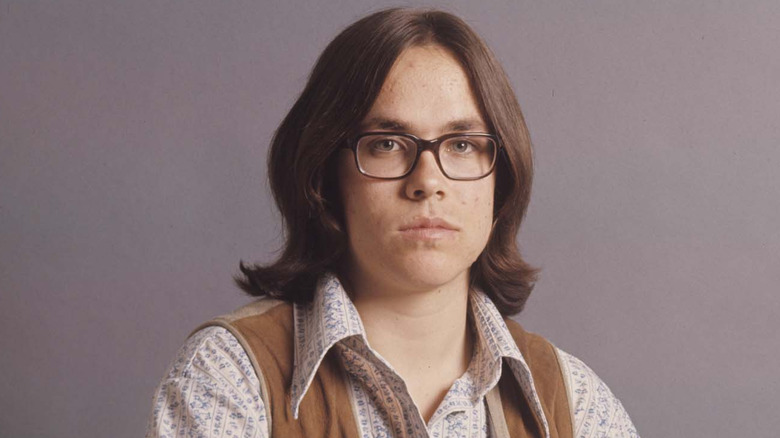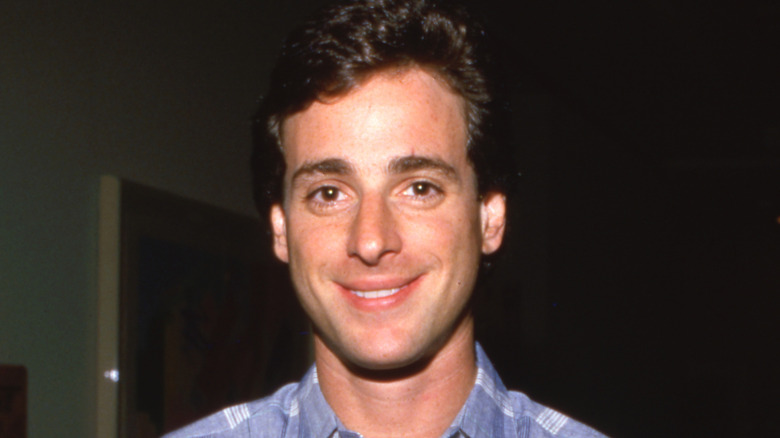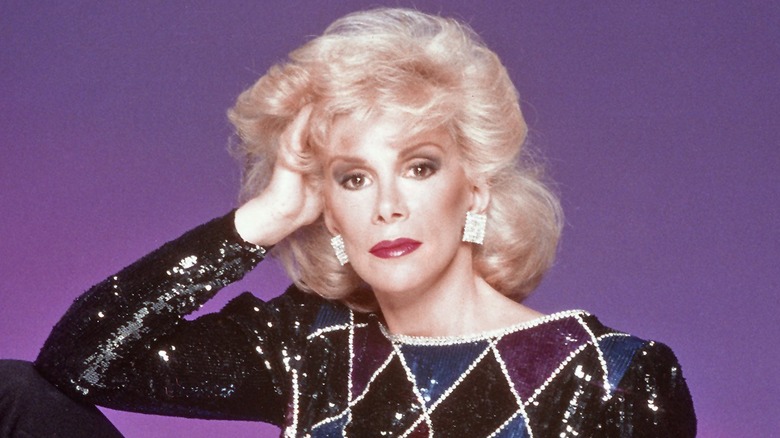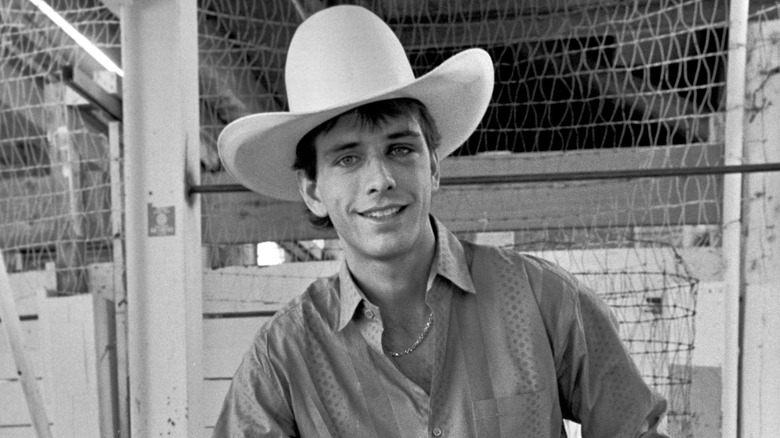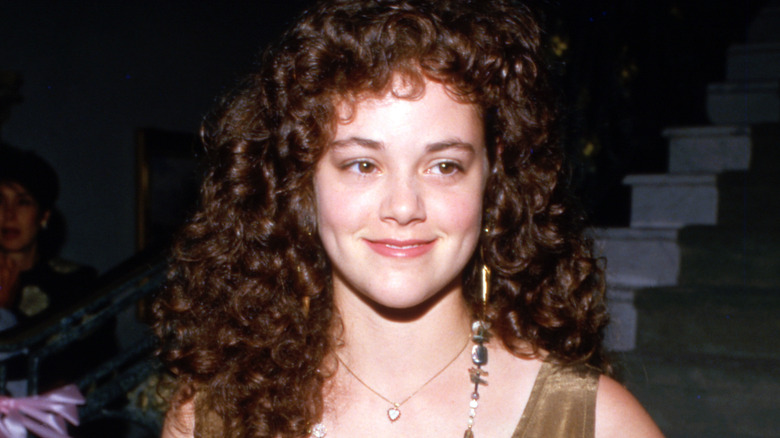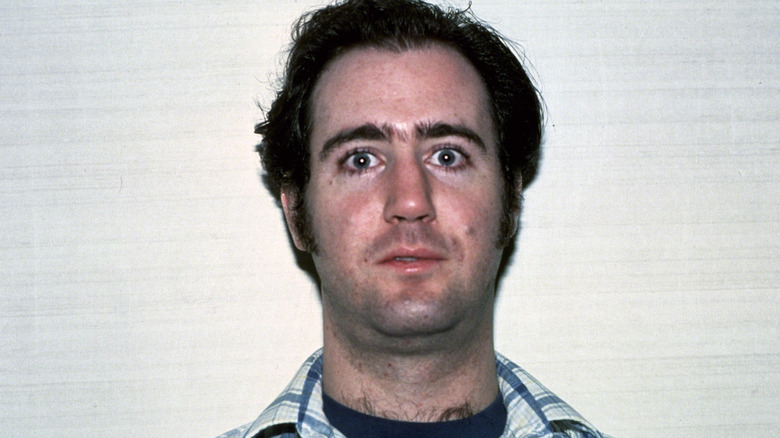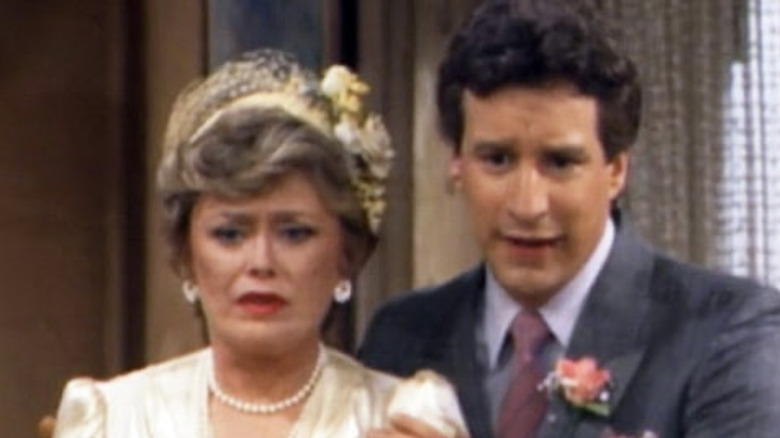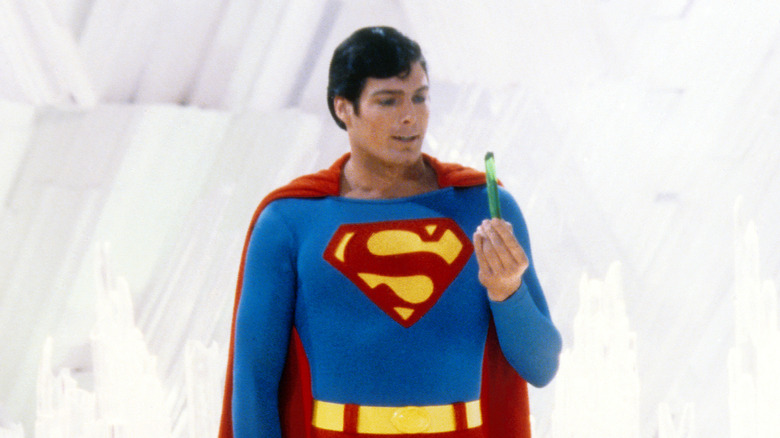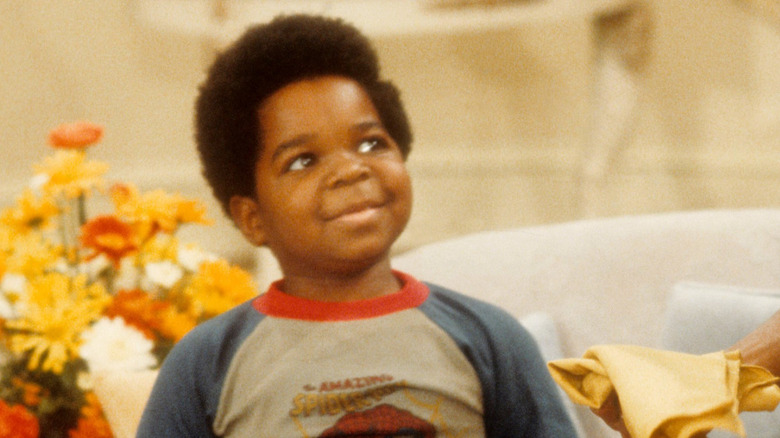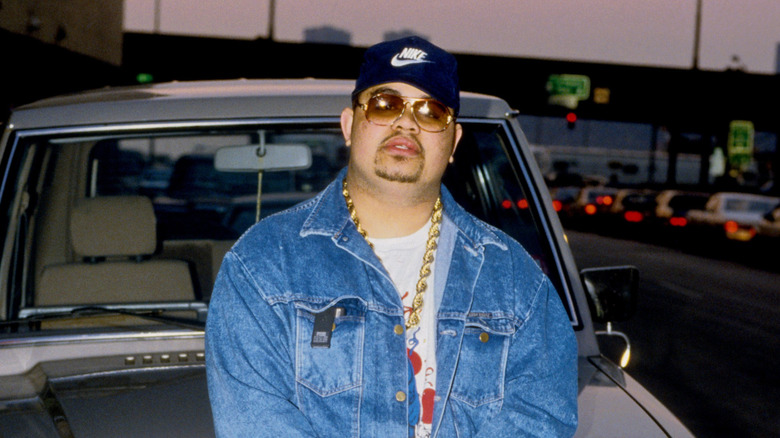'80s Stars Who Died In Bizarre Ways
A golden era of film, TV, music, and sports that also saw huge leaps forward in consumer technology, the 1980s is among the most heavily nostalgia-affected decades. Fondly recalled by multiple generations, major milestones, favorite personalities, and artists from the 1980s are referenced consistently in current pop culture and conversation decades later. And the 1980s certainly produced many enduring entertainers, stars, and true artists. While many of those human pillars of stardom may have started their careers before the 1980s, and continued working and making meaningful content into the 1990s and beyond, their involvement in quintessentially '80s projects will forever seal them in the collective memory as icons of the era of Reagan, Atari, and the VCR.
Those people lived a life that was singular, and tragically, their deaths were also unique. Their deaths are as sad as anyone else's, and their losses were felt by millions of strangers, but the methods by which they died will forever remain haunting. Here are some significant figures of the 1980s who died in strange and horrifying ways.
Jon-Erik Hexum
In addition to appearing in a handful of made-for-TV movies, Jon-Erik Hexum starred in two early 1980s action TV series. On the 1982 to 1983 show "Voyagers!" he played history-fixing time traveler Phineas Bogg, and beginning in 1984, he played a soldier pretending to be a jet-set model as a front for spy missions on "Cover Up."
Production on "Cover Up" was dragging along one day in October 1984, and Hexum found it interminable. After being informed of yet another delay, Hexum reportedly reached for a prop gun, held it up to his head, and joked, "Can you believe this cr**?" (via Entertainment Weekly). The actor pulled the trigger, and while prop weapons aren't supposed to fire projectiles, they do release a powerful charge. That energy went into Hexum's head, breaking off and sending a fragment of bone into the brain. Hemorrhaging ensued, and five hours of emergency surgery at the Beverly Hills Medical Center couldn't save his life. Hexum went into a coma and died six days after the shooting.
John Ritter
John Ritter starred in dozens of individual episodes of television in the 1970s, including a long arc on "The Waltons," but he became a star in the 1980s when "Three's Company" hit its stride. The suggestive and ribald ABC sitcom aired from 1977 to 1984, and the Ritter-focused spinoff called "Three's a Crowd" from 1984 to 1985, featuring the comic actor as the pratfall-prone, womanizing chef who had to pretend to be a gay man in order to live with two unmarried women.
On the set of the sitcom "8 Simple Rules for Dating My Teenage Daughter" in September 2003, nausea and chest pains sent Ritter to Providence St. Joseph Medical Center in Burbank, California, and doctors there treated the actor for what seemed to be a simple (but serious) heart attack. When Ritter showed no signs of improvement, more tests showed that the actor hadn't been in the middle of a heart attack at all, but was suffering from the complications of an as-yet undiagnosed ailment called an aortic dissection. Patients can live with the ailment so long as the flow of blood to coronary arteries isn't upset, or if one of those passageways tears or breaks: Unfortunately, that's precisely what happened to the 54-year-old Ritter, and doctors hadn't recognized the issue when he first checked into the hospital. Treatments for the correct diagnosis came too late, and Ritter died.
Randy Rhoads
After leaving popular heavy metal band Quiet Riot, classically trained guitarist Randy Rhoads was picked by a post-Black Sabbath Ozzy Osbourne — one of several '80s rock stars accused of serious crimes – to lead his first solo-era backing band. Speedy, loud, and always shredding, Rhoads played on Osbourne's first two albums, 1980's "Blizzard of Ozz" and 1981's "Diary of a Madman." An absolute superstar in the messed-up music industry of the 1980s, he rivaled Eddie Van Halen as the most respected guitarist in hard rock.
Following a show in Knoxville, Tennessee, in March 1982, the Osbourne entourage headed for Orlando, but when the bus's air conditioner started to break, the party made an unscheduled overnight stop in Leesburg, Florida, near the airstrip-outfitted Flying Baron Estates housing development. Driver Andrew Aycock was also a novice pilot, and he borrowed a Beechcraft Bonanza plane from a resident with whom he was friendly. On his second flight, Aycock brought along the band's makeup artist Rachel Youngblood and Rhoads. During that jaunt, he tried to fly as close as possible to the tour bus, where several members of the band were sleeping. He'd intended to good-naturedly frighten the musicians, but on his third dive, he lost control and crashed the aircraft. All three people on the plane died, including 25-year-old Rhoads.
Jeff Porcaro of Toto
Toto was quite likely the smoothest and most technically proficient soft rock band of the 1980s, and that's because its members had already honed their skills as some of the most frequently utilized session musicians around. Drummer Jeff Porcaro directed the band, which landed some hits in the late 1970s but exploded in the early 1980s. Along with most of Toto performing for Michael Jackson's mega-seller "Thriller," Toto's 1982 album "IV," which included the major hits "Africa" and "Rosanna," won Porcaro and company three Grammy Awards, including Album of the Year.
Making the real-life story of Toto rather tragic, Porcaro was tending to some yard work at his home in the San Fernando Valley of California in August 1992, when he was suddenly overwhelmed with sickness. By the time paramedics showed up, the drummer's breathing and heart had ceased, and doctors at the hospital where Porcaro was sent by helicopter were unable to restore his vital functions: the musician was pronounced dead at age 38.
While it was immediately clear that Porcaro died of a heart attack, doctors at first believed it to be the outcome of a fatal allergic reaction to the pesticides used in the yard work. An autopsy by the Los Angeles County Coroner cited hardened arteries as the true culprit in the death, caused by prodigious use of cocaine. No pesticides were found in Porcaro's body, and only traces of cocaine were found.
Kirsty MacColl
Kirsty MacColl's one-of-a-kind voice influenced all kinds of genres, from pop to rock to traditional music. After emerging with the British punk band Drug Addix, she took the country-rock "There's a Guy Works Down the Chipshop" to the upper reaches of the U.K. chart in 1981, and four years later repeated the task with a cover of folkie Billy Bragg's "A New England." But she's best known for 1987's "Fairytale of New York," the Pogues' sad story song that returns to the airwaves every Christmas season.
MacColl accompanied her family on a vacation in December 2000 to Cozumel, a resort island area in southeastern Mexico. While she played with her two teenage sons in the Chankanaab Reef, a legally preserved natural area specifically reserved for swimmers and divers only, an engine-powered 31-foot boat tore into the section at high speed. MacColl pushed her sons out of the way and into relative safety, but the vehicle's propeller made direct impact with the 41-year-old singer. An autopsy indicated that MacColl died instantly due to the severity of the injuries suffered to the head and chest, with one leg left almost separated from the rest of the body.
Bob Saget
During the 1980s stand-up comedy boom, Bob Saget frequented the many clubs of Los Angeles. In 1987, that led to a big break as the in-house comedian on CBS's "The Morning Program." By the end of that year, he'd begin an eight-year run in the role with which he'd always be associated: doting, kindly, widowed father of three Danny Tanner on the ABC sitcom "Full House."
Saget set out on the "I Don't Do Negative" stand-up comedy tour in January 2022, and after playing the second date in Ponte Vedra Beach, Florida, on January 8, 2022, he went to sleep in his room at the Ritz-Carlton Orlando. The hotel sent a member of its security team to perform a wellness check on Saget the next day after he didn't check out on time, and that's when the comic was discovered dead. Saget died of a head trauma, most likely sustaining an accidental impact on something in his room and then not thinking anything of it before promptly going to bed. The 65-year-old comedian died in his sleep.
Heather O'Rourke
With just a small appearance on "Fantasy Island" as her only acting experience, Heather O'Rourke was personally selected by Steven Spielberg to play a pivotal role in a horror film he was producing and co-writing. In 1982's "Poltergeist," 6-year-old O'Rourke played Carol Anne Freeling, lured and kidnapped by evil beings and taken to another plane that more or less occupied the same location as her family's home. "Poltergeist" was a hit — as was O'Rourke's creepy catchphrase, "They're here!" — and the actor played Carol Anne in two sequels.
When O'Rourke told her parents about unbearable abdominal pain in February 1988, she was quickly sent to Children's Hospital of San Diego for emergency surgery. Sadly, O'Rourke died during the procedure from complications of intestinal stenosis, an often fatal blockage in the small intestine that O'Rourke likely had for her entire life. The obstruction led to an infection, which turned into sepsis, and that stopped the heart of the 12-year-old actor.
Joan Rivers
After nearly two decades of regularly performing stand-up comedy on "The Tonight Show," host Johnny Carson tapped the well-known Joan Rivers to be the late-night institution's permanent guest host to fill in for the star's contracted regular breaks. When the Fox network started up in 1986, it brought in Rivers to host "The Late Show." The gig fizzled out quickly, but the host would recover quickly with the daytime series "The Joan Rivers Show."
To treat an ongoing problem with acid reflux and to address a displeasing transformation of her voice, Rivers elected to undergo a surgical procedure in September 2014. Before the operation, the staff at Yorkville Endoscopy in New York City administered the sedative propofol. That drug relaxed the comic's body to such a point where her heart stopped, starving Rivers' brain of oxygen long enough to cause irreversible and fatal damage. The comedian and host was 81 years old.
Ayrton Senna
Formula One racing is the most popular form of motorsport around the world, and Ayrton Senna was among the biggest superstars it ever produced. In a nine-year career that started in 1984, Senna crossed the finish line first in 41 races, including six titles at the illustrious Monaco Grand Prix. He was Formula One's overall world champion in three separate seasons.
During a race on the Imola circuit track in Italy on May 1, 1994, Senna was making a left corner turn at the high speed required of a Formula One driver, when his car unpredictably veered right. Senna's car immediately hit a wall straight on, and Senna died from injuries suffered in the crash. Debris from the accident entered his racing helmet and penetrated the 34-year-old's head, leading to multiple fatal skull fractures. What had caused the deadly crash in the first place was a problem with the steering column, modified and tweaked on Senna's request before his final race.
Jessica Savitch
Reporter and anchor Jessica Savitch rapidly climbed the ladder at NBC News upon joining the company in 1977. By the early 1980s, Savitch was anchoring the weekend editions of "The NBC Nightly News" and appearing throughout the network's primetime schedule, filing minute-long "NBC News Digest" briefs that aired during ad breaks. The four-time News Emmy Award winner, who negotiated one of the highest salaries in TV news history to that point ($500,000 a year), Savitch covered politics for PBS and anchored that service's documentary series "Frontline."
Under heavy rainfall on the night of October 23, 1983, Savitch and her fiancé, New York Post executive Martin Fischbein, drove away from a restaurant in New Hope, Pennsylvania. The sequence of events that transpired seems inexplicable. The rain was so abnormally heavy that Savitch missed a road and drove into gravel, missing two caution signs warning drivers about the nearby Delaware Canal. As a result, Savitch accidentally took her station wagon down a canal wall, sending it into the water where it flipped over. Neither Savitch nor Fischbein could get the doors of the car open and escape to safety, and they drowned in the canal, which was only about 5 feet deep at the place of impact. Savitch was 35.
Lane Frost
Inducted into the Pro Rodeo Hall of Fame, Lane Frost was a superstar of his sport, and he came out of the gate as one of the greats. Following a successful turn in the national high school rodeo championship, Frost turned pro. In 1986, he won so many of the circuit's events and titles that he captured the national championship, and a year later he won the rodeo championship of the world. Frost became a legend when he successfully rode a bull named Red Rock that had thrown off riders in more than 300 previous attempts.
During the Cheyenne Frontier Days Rodeo in Wyoming on July 30, 1989, Frost rode the bull Takin' Care of Business for so long and so well that he racked up a historically high score of 85 (out of 100). Just after thrilling the crowd of around 10,000, Takin' Care of Business charged Frost. One of the large animal's horns went into the rider's back, quickly fracturing several ribs. But that wasn't the fatal blow — that would come from a piece of broken rib severing one of Frost's major blood vessels. By the time he was rushed out for medical treatment, Frost had already lost a pulse, and doctors pronounced the 25-year-old rodeo star dead when he arrived at Cheyenne's Memorial Hospital.
Samantha Smith
Fame came for Samantha Smith in a surprising and wholesome manner. In 1982, and at the height of Cold War tensions, the then-fifth-grader from Maine sent a letter to Soviet Union and Communist Party head Yuri Andropov that gently asked for ways to avoid what looked like a certain nuclear war. Andropov wrote back, and since it actually helped lead to a de-escalation of hostilities between the two superpowers, Smith appeared on numerous TV talk shows agitating and advocating for peace. She was so famous that she accepted a supporting role on the TV drama "Lime Street" in 1985.
Serving in an unofficial capacity as a goodwill ambassador for the United Nations, Smith spoke at events and rallies around the world. In August 1985, Smith and her father were among the passengers onboard a small, commuter aircraft that crashed during its descent towards Auburn-Lewiston airport, near Smith's home in Maine. A federal investigation would cite numerous rare factors that all at once led to the accident, including pilot error, heavy rain, and equipment failure. Smith was 13 years old.
Rebecca Schaeffer
With only a few small parts and soap roles to her name, 19-year-old Rebecca Shaeffer was cast as a co-lead opposite "Mork and Mindy" star Pam Dawber in the latter's 1986 comeback sitcom, "My Sister Sam." The show about cool siblings in San Francisco was a major ratings hit in Season 1, but faltered in Season 2 and was canceled by CBS. Shaeffer quickly lined up work in a couple of feature films.
In July 1989, Shaeffer died at the age of 21 after being shot and killed at the front door of her apartment in Los Angeles. The day after the murder, Robert John Bardo was arrested for the crime, whom police labeled as an obsessive fan. During the subsequent murder trial, the security chief from the studio where "My Sister Sam" had been taped testified that Bardo had often shown up bearing gifts and unwanted attention for Shaeffer. The actor's death was among the first times that the general public was made aware of stalking, and it led to California becoming the first state (out of all 50) to pass laws that defined and outlawed the practice.
Andy Kaufman
A highly experimental comedian and performance artist, Andy Kaufman delighted and entertained as much as he baffled and enraged. He never broke character, no matter who he was portraying, such as when he ported his "Foreign Man" persona from his comedy act to the sitcom "Taxi" in the form of Latka Gravas, or an obnoxious sexist jerk version of himself who challenged women to wrestle him at arenas.
Kaufman had rolled out so many arch and public comedy bits in the late 1970s and early 1980s that when the comedian and actor died in May 1984, a contingent of his fans and even some of his closest associates thought that the death was a put-on, too. That's just how shocking it was when Kaufman died, particularly on account of his age, his lifestyle choices, and the rapid timeline of the disease responsible. At the time, conventional wisdom held that lung cancer was a disease that developed primarily in smokers. Kaufman didn't use tobacco, but he died from complications of lung cancer nevertheless. "In fact, he was a health food fanatic," Kaufman's publicist, Estelle Endler, told The New York Times. The entertainer was diagnosed with cancer in January 1984, and he died four months later at the age of 35.
Benji Gregory
One of the silliest pop cultural crazes of the 1980s sprang from the 1986 to 1990 NBC family sitcom "ALF." The title character was a furry, eccentric, cat-eating alien who crashed on Earth and hid with the suburban Tanner family. They all hated ALF, except for the littlest Tanner, Brian, who was often the alien's accomplice in his wacky schemes. From the ages of 8 to 12, Benji Gregory portrayed Brian Tanner, a capstone on a bustling child-acting career that included voice roles in "Fantastic Max" and "Pound Puppies," and parts in "Jumpin' Jack Flash" and "Amazing Stories."
In young adulthood, Gregory dropped his stage name and, as Benjamin Hertzberg, entered into the U.S. Navy, working in the weather forecasting department on an aircraft carrier. On June 13, the body of the 46-year-old as well as that of his service dog were found in Hertzberg's car, parked outside of a bank in Peoria, Arizona. About a month later, the former actor's family announced the death as well as the results of an investigation. "We believe he went there the evening of the 12th to deposit some residuals and never got out of the car to do so," Rebecca Hertzberg-Pfaffinger, the "ALF" cast member's sister, wrote on Facebook. "He fell asleep and died from vehicular heatstroke." Gregory was 46 years old.
Charles Levin
One of those consistently working actors with a recognizable face but not so much a familiar name, Charles Levin appeared in more than 60 projects, with his most notable work delivered in the 1980s. Audiences might remember him from roles like a record store manager in "This is Spinal Tap," waitress-courting cop Elliot Novak on two seasons of "Alice," and Eddie Gregg on "Hill Street Blues. Levin's character, live-in cook Coco, disappeared from the iconic house of "The Golden Girls" after being cut after the pilot episode.
On July 8, 2019, Levin's son filed a missing persons report after not hearing from the actor for about a week. Authorities in and around Levin's home of Grants Pass, Oregon, launched an investigation, and days later state troopers discovered Levin's car in a rural, heavily forested, and tough-to-access area more than a quarter-mile from a road. Inside the car, police found Levin's dog, Boo-Boo Bear, deceased, and the actor on the floor of a nearby ravine. The 70-year-old actor's body was unclothed, had rapidly decomposed, and it bore signs that turkey vultures had scavenged the remains.
Christopher Reeve
For most of the 1980s, there was only one big-budget superhero movie franchise — the four-part "Superman" series. Little-known soap actor Christopher Reeve won the role of the Man of Steel (and his mild-mannered alter ego, Clark Kent) for 1978's "Superman," and his characters saved the day in three '80s installments: "Superman II," "Superman III," and "Superman IV: The Quest for Peace," which Reeve wrote.
Reeve was an experienced equestrian athlete, and while competing in a competition in May 1995, his horse decided against a jump mid-launch, throwing its rider forward. Reeve fractured several vertebrae in the spinal column, leaving him permanently paralyzed from the neck down and requiring the use of a respirator to breathe. The actor lived for almost an entire decade after the injury, which only indirectly led to his death. Because he used a wheelchair, Reeve was more susceptible to pressure wounds, a type of skin ulcer. In October 2004, while receiving medical care to treat an infected pressure wound, Reeve had a heart attack and fell into a coma. Doctors at the Northern Westchester Hospital in New York were unable to save Reeve, and he died at the age of 52.
Scott Smith of Loverboy
The sound of the early 1980s was New Wave, and few bands delivered that high-energy blend of hard-rocking guitars and shimmering synthesizers better or more successfully than Loverboy. Bass guitarist Scott Smith joined the band very early on, and it's his licks that can be heard on all of Loverboy's hits, like "Turn Me Loose," "Hot Girls in Love," and "Working for the Weekend."
Loverboy performed at a Juvenile Diabetes Foundation benefit in Vancouver on November 30, 2000, after which Smith and three others departed the city on a 37-foot sailboat, intending to sail down the West Coast to Mexico. As the craft approached San Francisco, treacherous weather led to 20-foot-tall ocean waves, one of which threw Smith off the deck of his boat and into the sea. The musician's sailing companions were unable to locate Smith, nor could Coast Guard helicopters or two search-and-rescue boats. Smith's family then launched a private search, which also didn't find the overboard bassist. Smith's body was never recovered and never washed ashore, and he was presumed to have died at the age of 45.
Bill Paxton
After Bill Paxton's New Wave band ran its course, the musician became an actor. His career was long and accomplished, and it included prominent roles in 1990s smashes like "Twister" and "Titanic," and he netted three Golden Globe nominations for HBO's "Big Love." Being an '80s movie scene-stealer is where it all started for Paxton. He led a group of toughs in "The Terminator," played unhinged older brother Chet in "Weird Science," and delivered the memorable "Game over, man, it's game over!" as Private Hudson in "Aliens."
Paxton was a guest on the "WTF with Marc Maron" podcast in 2017, and he publicly discussed a childhood medical issue for the first time. At age 13, his doctors tied the pain he was experiencing to rheumatic fever. The disease can lead to heart damage over time, and in 2017, Paxton had procedures to alleviate an aortic aneurysm and to replace an aortic valve. In February 2017, two weeks after the surgeries, Paxton died from a stroke at age 61. The actor's family later sued Paxton's cardiovascular surgeon and Los Angeles' Cedars-Sinai Medical Center, citing negligence, battery, and wrongful death, on account of how the doctor didn't reveal beforehand that the operational method he employed on the actor was unproven and potentially dangerous.
Gary Coleman
Perhaps the most famous child star of the early 1980s, Gary Coleman started making TV audiences laugh in the late '70s with appearances on "The Jeffersons" and "Good Times" before he got a starring role, at age 10, on "Diff'rent Strokes." He played the preternaturally wise and gregarious Arnold Jackson, adopted son of a wealthy benefactor, who until 1986 had the world repeating his catchphrase, "Whatchu talkin' 'bout, Willis?"
Coleman coped with rare and challenging medical issues for the entirety of his life. Shortly after he was born, doctors diagnosed nephritis, a congenital kidney issue. Coleman's kidney transplants came at the ages of 5 and 17, and he was on dialysis treatment for his entire lifetime. In 2009, Coleman needed heart surgery and contracted pneumonia during his recovery. His health took a series of tragic turns in early 2010. After sustaining a seizure while appearing on the newsmagazine "The Insider," Coleman suffered a fall, and in May 2010, he had a brain hemorrhage at his home in Utah. Admitted that day to the Utah Valley Regional Medical Center, Coleman lost consciousness and was briefly on life support machines before he died at the age of 42.
Teena Marie
While auditioning for Motown Records in the late 1970s, 20-year-old Teena Marie's singing caught the attention of the label's funk superstar Rick James. He helped Marie (real name Mary Brockert) jumpstart her career, and they dueted on the minor hit "I'm a Sucker for Your Love." When the 1980s began, Marie, also a songwriter and guitarist, landed one smash after another on the R&B chart, such as "I Need Your Lovin'," "Square Biz," and "It Must Be Magic," which crossed over to the dance list and the main pop chart. In 1984, Marie wrote and recorded "Lovergirl," a No. 4 hit.
The musician's health declined rapidly following an unfortunate and detrimental injury in 2004. While sleeping in a hotel room, a framed picture fell off the wall and onto Marie's head. The singer suffered a concussion, and for the rest of her life, Marie occasionally sustained seizures. In November 2010, a major, or grand mal seizure, caused Marie to fall and break two ribs. A month later, and after she'd discontinued anti-seizure medication due to negative side effects, Marie died while taking a nap at her Los Angeles home. She was 54 years old. However, an autopsy couldn't pinpoint a conclusive cause of death, and the Los Angeles County coroner's office ruled that Marie died of natural causes.
Heavy D
Heavy D was one of the first rappers with a radio-friendly sensibility, helping to get hip-hop music into the mainstream in the 1980s. Nicknaming himself "the overweight lover," the musician, as the star of the collective Heavy D and the Boyz, enjoyed his first chart hits in 1988 and 1989 with songs like "Don't You Know," "We Got Our Own Thang," and "Somebody for Me."
On November 8, 2011, Heavy D went shopping and then collapsed outside his home in Beverly Hills, California. A neighbor called for paramedics, and the rapper was alert and awake when he was transported to Cedars Sinai Medical Center, where he died about an hour later. Heavy D was 44 years old. Initially, authorities floated the possibility that the musician died from complications of pneumonia, but an autopsy performed by the Los Angeles County coroner's department discovered a pulmonary embolism, a blood clot that lodges in a lung and can be fatal. The blockage most likely moved into the rapper's lung after forming in a leg without any symptoms, possibly during a long-haul flight to or from a Michael Jackson tribute concert in Wales at which Heavy D had performed.
